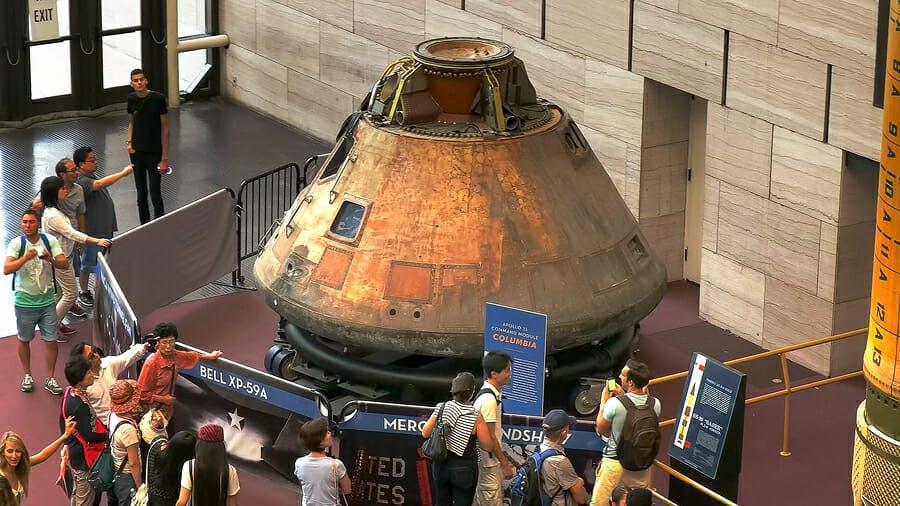Getting to the moon, 50 years ago as of July 20, required an army of scientists, engineers, and technicians, recruited to work on developing technology and systems that did not exist. At its peak in 1967, the Apollo program employed over 400,000 people. Most were young with barely any experience. When Neil Armstrong stepped on to the surface of the moon, the average age of engineers at Mission Control was 28. Recruiting this massive workforce was not easy. NASA and its contractors needed every engineer and scientist they could find. One engineer’s experience was typical of how hiring worked at the time.
We decided we’d apply for a job, so we got in our car one day and came down here to the Cape. Two or three people took us around to different parts of the operation. They asked us, “Where do you think you would like to work?” I picked ground instrumentation systems in the CIF, the central instrumentation facility. Charlie picked the ACE, the automated checkout for the spacecraft, the Apollo capsules. We hadn’t even graduated at the time. We came back home, and within a week, we each got a telegram. They offered us both a job as a GS-7, which was $7,729 a year.
A lot of people were hired sight unseen, just based on their grades and major. Many applicants were hired based only on a mailed-in resume and cover letter. Bringing them to the Cape was not practical, and even making a phone call was often not easy. NASA was reaching out to every college that graduated electrical and mechanical engineers, and had some very creative ad campaigns. One appealed to science fiction enthusiasts, inviting them to turn their passions into a job.
Astronauts were also enlisted in recruiting efforts. They were already well known, as a result of the Mercury and Gemini programs that preceded Apollo. They were a huge draw when they visited college campuses and students lined up to shake their hands.
Pioneering Diversity
The Apollo program also gave a big boost to increasing diversity in hiring. At the time there were very few women and minorities employed at NASA, and most worked as janitors. The most prominent professionals were three African-American mathematicians whose story was the subject of the movie “Hidden Figures.” In 1964, the Marshall Space Center in Alabama began a Cooperative Education Program, recruiting at historically black colleges. It was headed by Charlie Smoot, the first African-American recruiter hired at NASA. He hired seven students to become the first African-American co-op engineers working for NASA. The numbers were tiny but the visibility of these hires had a positive impact of diversity recruiting efforts and represented significant advancement at a time when much of the south was segregated.
Newspapers like the New York Times published stories about these efforts. The first minority astronaut was a U.S. Air Force pilot Robert Lawrence, hired in 1967 to fly aboard the Manned Orbiting Laboratory. Unfortunately, he was killed in a training accident, six months later.
There were about 5,500 women employed at NASA, but most worked as secretaries. There were some notable exceptions, such as Judy Sullivan, the first woman engineer hired, and JoAnn Morgan, the only woman on the launch team.
Recruiting the Right Stuff
Finding people qualified to be astronauts was another challenge. The first problem was defining an astronaut’s role. At first, they were supposed to be nothing more than observers who would view and document what was happening. But it soon became obvious they would have to interact with the systems and controls in the spacecraft. Based on this, NASA decided it needed pilots. For the Apollo program, the requirements were:
- Hold a bachelor’s degree or equivalent in engineering.
- Be a graduate of a test pilot school.
- Have at least 1,500 hours of flying time.
- Be younger than 35 years.
- Be shorter than 6 feet.
The height requirements simply reflected the limits of space inside the Apollo capsule. 49 candidates were selected from over 900 applicants. Emphasis was shifted from flight experience to superior academic qualifications. The majority of those selected for the astronaut corps for Apollo had a doctorate or equivalent experience in natural sciences, medicine, or engineering.
The screening process was rigorous and involved a battery of tests that measured physical, psychological, and intellectual fitness for the job. In addition to pressure suit tests, acceleration tests, vibration tests, heat tests, and loud noise tests, each candidate had to prove his physical endurance on treadmills, tilt tables, with his feet in ice water, blowing up balloons until exhausted and doing math in 145-decibel rooms. (People speak at 60 decibels on average).
The Apollo program did much more than land a man on the moon. It pioneered creative recruiting techniques, helped kick-start diversity hiring, and demonstrated the value of assessments in finding “the right stuff.” Neil Armstrong’s words — “A small step for man, a giant leap for mankind” — may have carried more meaning than he realized.
Correction/editor’s note: This article originally said that “almost 2 percent of the American workforce” worked on the moon project.
